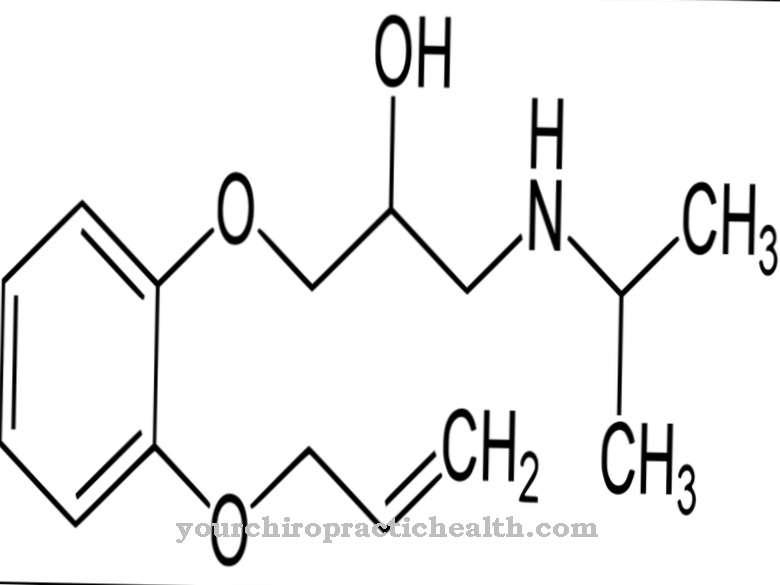The active substance Lamivudine is used to treat the immune deficiency disease AIDS and hepatitis B infections. It belongs to the group of antivirals.
What is HIV Infection?
Lamivudine is a nucleoside reverse transcriptase inhibitor (NRTI), which is a chemical analog of cytidine, which is a nucleoside. The drug is used to treat HIV-1 infections such as AIDS. Although the drug is not able to cure the disease, it does extend the life expectancy of patients.
Lamivudine is manufactured by the British pharmaceutical company GlaxoSmithKline. The virostat has been used in Germany since 1995. It is now one of the most widely used nucleoside reverse transcriptase inhibitors in the treatment of HIV infections. It is often combined with abacavir (ABC), which is also part of the NRTI.
Pharmacological effect
Lamivudine is a so-called prodrug. What is meant is an active ingredient precursor that is not effective against the viruses. It is only within the organism that it is converted into the actually effective medicinal substance. This has the ability to inhibit the enzyme reverse transcriptase. This effect stops the HIV virus from multiplying. By reducing the number of viruses in the blood, the amount of special white blood cells such as CD4-positive T lymphocytes increases at the same time. This process leads to a stronger immune defense in the body.
A disadvantage of lamivudine is that the HI virus quickly becomes insensitive to the individual active ingredients due to its high level of versatility. To avoid this resistance, the antiviral is combined with other active ingredients. In the context of AIDS therapy, three active ingredients are usually used at the same time.
The enzyme reverse transcriptase is also important for the hepatitis B virus (HBV) to be able to reproduce. If lamivudine is administered to treat hepatitis B, it reduces the number of viruses and relieves the liver. If there is chronic hepatitis B, the patient receives lamivudine as a single preparation. The dose is lower than that used to treat HIV infection.
The oral bioavailability of lamivudine is rated as high at around 80 percent. There are hardly any influences from ingestion of food. The active substance's plasma half-life is about six hours. It is only broken down through the kidneys.
Medical application & use
Lamivudine is used to fight the human immunodeficiency virus HIV, which causes AIDS. In some cases, the antiviral also ensures that the disease does not break out until a later point in time. Basically, the drug increases the life expectancy of AIDS patients and improves their quality of life.
Lamivudine is also suitable for treating hepatitis B. The drug counteracts the risk of liver cirrhosis. Sometimes the disease can even heal. In the event that a liver transplant has been performed, lamivudine will reduce re-infection of the organ with hepatitis B viruses that are still in the body.
The virostatic is administered in the form of tablets. Their dose is between 100 and 300 milligrams. A solution can also be taken. Usually, the patient receives lamivudine once or twice a day, regardless of meals.
Risks & side effects
Although lamivudine is generally well tolerated, various undesirable side effects are still possible. These primarily include impaired performance, tiredness, headache, chills, fever, swelling of the lymph nodes,]] diarrhea]], nausea, vomiting, digestive problems, general malaise and flu-like symptoms.
Some patients get infections more often. Other side effects can include liver dysfunction, an inflamed liver, an increase in the amylase enzyme, joint problems, muscle pain and hair loss.
In the case of AIDS, a deficiency in white and red blood cells and platelets is more common. Patients with hepatitis B are less likely to suffer from it.
In AIDS patients, symptoms may even worsen at the beginning of lamivudine therapy. The reason for this is a reaction of the stronger immune system to germs such as viruses, bacteria, fungi or parasites that are still in the body. Doctors then speak of an immune reactivation syndrome. In most cases, however, symptoms will improve in about four weeks.
If there is hypersensitivity to lamivudine, therapy with the active ingredient must not be carried out. The dose may need to be adjusted if the kidney function is impaired. If symptoms such as pain in the hands and feet, tingling, numbness, enlargement of the liver or inflammation of the organ occur, the attending physician must carefully weigh the risks and benefits of the therapy.
The same applies to the use of lamivudine during pregnancy and breastfeeding. Animal experiments have shown harmful effects on the unborn child. However, it is still unclear whether these risks also exist in humans. It is generally recommended that lamivudine should not be given in early pregnancy. In the event of an HIV infection, the patient must refrain from breastfeeding her child. Otherwise there is a risk that the HI virus will pass onto the child with the breast milk.
The administration of lamivudine to children under three months of age is fundamentally excluded, as the knowledge about the effect of the agent is insufficient for them. In older children, the dosage of the drug depends on their body weight and the course of the disease.
Because of the neurotoxic effects of lamivudine, no other drugs with a similar effect should be administered. These include a. Cisplatin, vincristine, isoniazid and ethambutol.








.jpg)



















